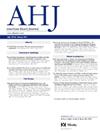使用改良的分层综合结果进行胜率分析:PARAGLIDE-HF 的启示。
IF 3.7
2区 医学
Q1 CARDIAC & CARDIOVASCULAR SYSTEMS
引用次数: 0
摘要
背景:胜率(WR)是报告综合结果的一种新兴替代方法,它优先考虑具有临床意义的事件,如死亡率,同时纳入替代指标。然而,在权衡其优点的同时也应考虑其局限性,尤其是较低等级结局的影响。本研究对 PARAGLIDE-HF 试验进行了二次分析,使用修改后的分层综合结果进行了 WR 敏感性分析,以评估 WR 敏感性分析的实用性以及沙库比特利/缬沙坦与缬沙坦的疗效:PARAGLIDE-HF比较了射血分数大于40%的心力衰竭(HF)患者(样本数=466)的沙库瑞利/缬沙坦与缬沙坦的疗效。主要分析的分层结果包括心血管死亡、HF住院、HF急诊以及N-末端前B型钠尿肽(NT-proBNP)的变化,下降25%即为获胜。在预先指定的射血分数≤60%的亚组(N=357)中,沙库比特利/缬沙坦对分层结果显示出治疗效果(WR,1.46;95% CI,1.08-1.97)。该亚组的敏感性分析包括1)排除 NT-proBNP 的变化;2)用 10% 或 50% 代替 NT-proBNP 25% 的比例变化;3)在分级结果中包括肾脏结果。除了 WR 外,还提出了胜率(WO),其中 50%的并列关系被分配到 WR 的分子和分母中,这可能是对 WR 更合适的修改,因为它考虑到了并列关系的存在:排除 NT-proBNP(WR,1.49;95% CI,1.00-2.22;WO,1.12;95% CI,1.00-1.26),将 NT-proBNP 临界值从 25% 调整到 10% 或 50% (WR,1.41;95% CI,1.06-1.89;WO,1.27;95% CI,10% 为 1.04-1.56;WR,1.54;95% CI,1.11-2.12;WO,1.25;95% CI,1.06-1.48(50%),纳入肾脏结果(WR,1.44;95% CI,1.07-1.94;WO,1.28;95% CI,1.05-1.56)一致倾向于沙库比曲/缬沙坦:多项WR敏感性分析表明,在射血分数大于40%至60%的患者中,沙库比曲/缬沙坦与缬沙坦相比具有一致的治疗优势。未来的研究可考虑预设WR敏感性分析,以全面评估治疗效果:试验注册:PARAGLIDE-HF;ClinicalTrials.gov ID,NCT03988634 (https://clinicaltrials.gov/study/NCT03988634)。本文章由计算机程序翻译,如有差异,请以英文原文为准。
Win Ratio Analyses Using a Modified Hierarchical Composite Outcome: Insights From PARAGLIDE-HF
Background
The win ratio (WR) is an emerging alternative for reporting composite outcomes, prioritizing clinically significant events such as mortality while incorporating surrogate measures. However, its benefits should be weighed against limitations, particularly the influence of lower hierarchical outcomes. This secondary analysis of the PARAGLIDE-HF trial performed a WR sensitivity analysis using a modified hierarchical composite outcome to assess the utility of WR sensitivity analysis and the efficacy of sacubitril/valsartan versus valsartan.
Methods
PARAGLIDE-HF compared sacubitril/valsartan with valsartan in heart failure (HF) patients with ejection fraction >40% (N = 466). A hierarchical outcome in the primary analysis included cardiovascular death, HF hospitalizations, urgent HF visits, and change in N-terminal pro–B-type natriuretic peptide (NT-proBNP), with a 25% decrease considered a win. In the prespecified subgroup with ejection fraction ≤60% (N = 357), sacubitril/valsartan showed a treatment effect on the hierarchical outcome (WR, 1.46; 95% CI, 1.08-1.97). Sensitivity analyses for this subgroup included: (1) excluding NT-proBNP change, (2) substituting the 25% proportion change of NT-proBNP with 10% or 50%, and (3) including renal outcomes within the hierarchical outcome. In addition to the WR, the win odds (WO), in which 50% of the ties are allocated to both the numerator and denominator of the WR—a potentially more suitable modification of the WR that accounts for the presence of ties—were presented.
Results
Excluding NT-proBNP (WR, 1.49; 95% CI, 1.00-2.22; WO, 1.12; 95% CI, 1.00-1.26), adjusting the NT-proBNP threshold from 25% to 10% or 50% (WR, 1.41; 95% CI, 1.06-1.89; WO, 1.27; 95% CI, 1.04-1.56 for 10%; and WR, 1.54; 95% CI, 1.11-2.12; WO, 1.25; 95% CI, 1.06-1.48 for 50%), and incorporating renal outcomes (WR, 1.44; 95% CI, 1.07-1.94; WO, 1.28; 95% CI, 1.05-1.56) consistently favored sacubitril/valsartan.
Conclusions
Multiple WR sensitivity analyses support a consistent treatment benefit of sacubitril/valsartan versus valsartan in patients with ejection fraction >40% to 60%. Future studies could consider prespecifying WR sensitivity analysis for comprehensive assessment of treatment effects.
Trial Registration
PARAGLIDE-HF; ClinicalTrials.gov ID, NCT03988634 (https://clinicaltrials.gov/study/NCT03988634).
求助全文
通过发布文献求助,成功后即可免费获取论文全文。
去求助
来源期刊

American heart journal
医学-心血管系统
CiteScore
8.20
自引率
2.10%
发文量
214
审稿时长
38 days
期刊介绍:
The American Heart Journal will consider for publication suitable articles on topics pertaining to the broad discipline of cardiovascular disease. Our goal is to provide the reader primary investigation, scholarly review, and opinion concerning the practice of cardiovascular medicine. We especially encourage submission of 3 types of reports that are not frequently seen in cardiovascular journals: negative clinical studies, reports on study designs, and studies involving the organization of medical care. The Journal does not accept individual case reports or original articles involving bench laboratory or animal research.
 求助内容:
求助内容: 应助结果提醒方式:
应助结果提醒方式:


